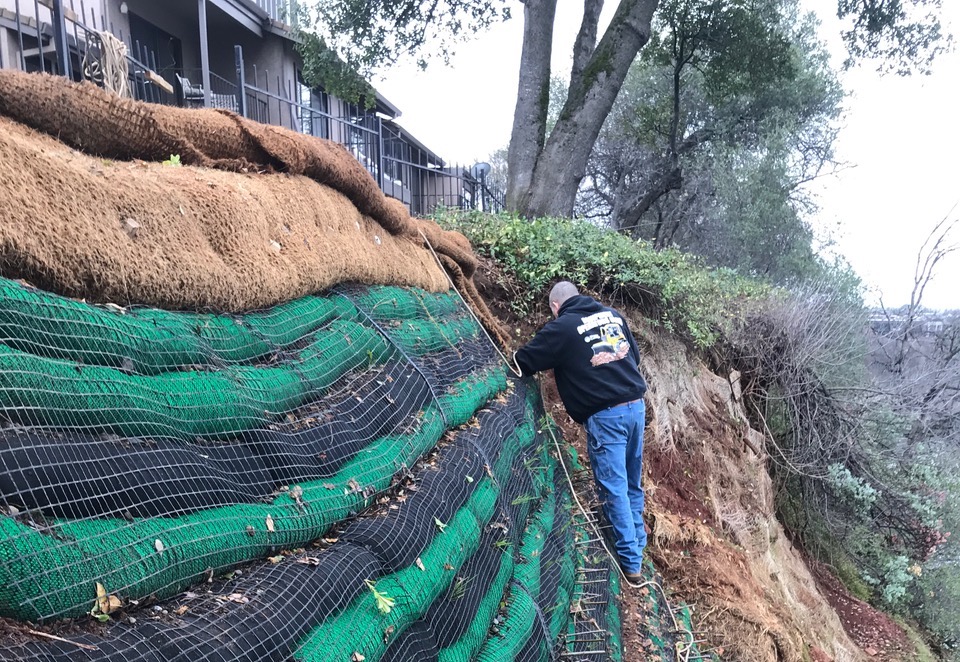
16 Jan INNOVATIVE Vegetated Mechanically Stabilized Earth (VMSE) Structure
This Biotechnical Soil / Slope Stabilization used to protect top of slope recession on the Bluffs above Redding’s Sacramento River.

This VMSE detail, along with widely referenced design and construction guidance, comes from BioDraw3.0 and ESenSS Manuals with CAD-ready digital files. See Store
The Problem

Fig 1 – The bluffs are about 200’ high. We decided to start the structure at a stable platform approximately 25’ vertical below top of bank.

Fig. 2 The “toe” of the structure utilized Coir Logs anchored with Gripple anchors and wrapped in Biaxial Geogrid
The Challenges


Site goals, opportunities and constraints were:
1. There was no equipment access between the condos, wheelbarrow only.
2. The desired outcome was to return the slope to restore some of the contours. That would require an average of roughly 3-4ft of fill horizontally.
3. A soldier pile wall or adding compacted layers of engineered fill, 0.5:1 slope over 20-ft high was not feasible.
4. A lighter fill comprised of 50% sandy/gravelly loam mixed with 50% composted OM, reinforced with geogrid and roots seemed possible given the wheelbarrow transport and hand shovel restrictions.
5. A rule of thumb for bioengineering on steep adverse soils is to compensate for lack of compaction (engineered soils) with lots of reinforcement (geogrids and geotextiles initially and variable roots long term) and use relatively free draining soils with added cohesion (in the form of fungi, humus, and organic matter).
6. Compost-filled socks were selected for both reinforced fill and an excellent growth medium. We relied on compost socks for over half of the needed fill, and was also used as the new slope facing. The compost was relatively light so we weren’t putting an inordinate amount of weight on the steep slope and the “encapsulated” compost socks allows us many opportunities to “anchor” the structural elements to each other and to the slope.
7. The Filtrexx Siltsoxx and Growsoxx proved to be perfect product components for this project. Growsoxx are produced to grow vegetation really well. The compost filling them is certified compliant with the US Compost Council and there are many successfully documented projects using the Growsoxx to establish “living walls”. The Siltsoxx, on the other hand, are particularly designed to filter sediment-laden water. Because they are filled with a larger gradation of composted chips and stems, averaging 5/8” diameter, they allow free drainage but and are thought to be less effective as a growing medium.
8. I used some specific rationale in selecting both Siltsoxx and Growsoxx for this job. The material enveloping the Siltsoxx (green geotextile) appears stronger and longer lasting. If we use the Siltsoxx along the horizontal areas “lifts” where we plant / install willow branches (brushlayering) then having a super growth medium on the slope surface is not that important. Remember the willows will root from deeper into the slope. And the bigger wood chip gradations will last longer.
9. I further theorized that the Growsoxx would be better used behind the Siltsoxx, deeper in the slope, when brushlayering is used. That is where the willow roots will need good growth medium. Conversely, the Growsoxx will be more effective on the slope outer face when we are relying on native grasses and grass plugs to take over.








